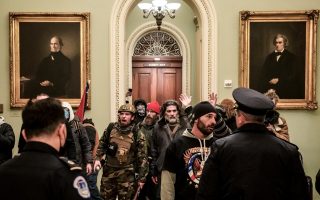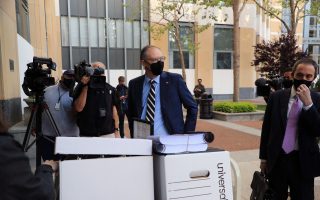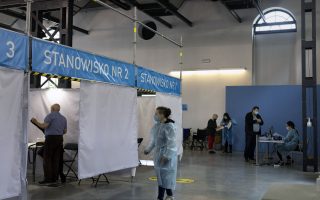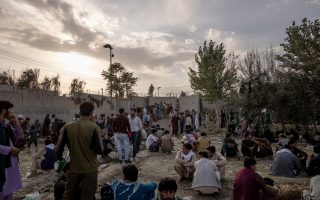In Shanksville, preserving the memory of 9/11 and the wars that followed
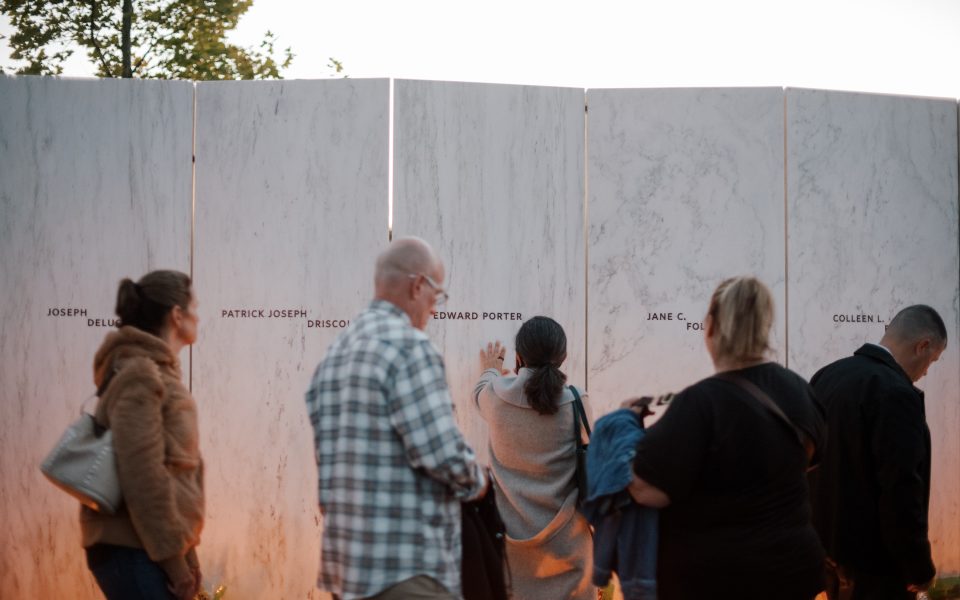
When the plane crashed in the empty field north of town, the schools let out early. Katlin Rodriguez, 11 at the time, waited in a cafeteria full of crying and shocked classmates for her mother and stepfather to come and take her home. When they showed up, they had brought along a family friend. “Don’t worry,” said the friend, a teenager who announced he had just enlisted. “We’re going to get them. We’re going to get the ones who did this.”
On a muggy Friday morning 20 years later, Rodriguez, now the wife of a Marine and the mother of a 6-year-old girl, was planting American flags in a small field not far from where Flight 93 went down outside Shanksville. About a dozen people were with her, each flag they planted representing one of 7,049 U.S. service members who had died in the wars that were waged since that late summer morning in 2001.
“A lot of the kids I went to school with, they enlisted,” Rodriguez said, looking out across the field. “It made a lot of us feel more connected to the larger world.”
By the time that the plane went down in Pennsylvania, the larger world was already reeling. The streets of downtown Manhattan were filled with dust clouds and terror, as the south tower of the World Trade Center had just collapsed. In Washington, federal officials and city residents were bracing for more attacks as flames poured out of the western side of the Pentagon. People across the country sat in shock in front of their televisions, waiting to hear what institution might be hit next.
Unlike the Pentagon or the World Trade Center, Somerset County, Pennsylvania, was not a target on Sept. 11, only a place that Flight 93 was passing over on the way to the terrorists’ grim objective in Washington. People did not live in Stoystown or Friedens or Shanksville, a tiny town without a traffic light, because they wanted to be near the levers of global power.
But when the passengers and crew of United Flight 93 attempted to seize control from their hijackers and the plane went plummeting into the Pennsylvania countryside, Shanksville suddenly became a battlefield in an international conflict. Once unthinkable new duties were now thrust upon the Fire Department, the county coroner, the nearby state troopers, the local historical society, the neighbors living near the crash site and, all across the country but here especially, the young people who suddenly found themselves coming of age in a time of war.
“He was angry,” Kathy Hause-Walker said of her son, Brian, who grew up in Stoystown, a little village a few miles from Shanksville. “It was like being violated.” A 22-year-old father of two in September 2001, he enlisted in the Air Force that December. He was not alone.
In the first six years of the wars in Afghanistan and Iraq, according to research cited in a 2016 article in the University of Memphis Law Review, soldiers from Somerset County were wounded in action at a rate higher than 97% of U.S. counties.
Staff Sgt. Brian Hause was sent to Iraq in 2008, said Kathy Hause-Walker, who was gathering a bundle of flags to plant that Friday morning. One of the flags in the field was for him; he died on a base north of Baghdad.
The field was part of a new commemorative site called Patriot Park, which is less than a mile from the Flight 93 National Memorial. That memorial, run by the National Park Service, sits on a quiet expanse of more than 2,000 acres, and includes a museum, a wall engraved with the names of the 40 passengers and crew members and an open meadow of thistle and goldenrod. It opened to the public 10 years ago and, with the 2018 dedication of a tower of wind chimes called the Tower of Voices, is now complete.
The groundbreaking for Patriot Park, which is run by a group of local residents — some of them veterans, most of them retirees — was this past July. Ultimately, the organizers envision a huge, star-shaped plaza with bronze statuary and walkways of engraved brick, but for now it is managed by local volunteers with power tools and free mornings.
In the first weeks and months after the attack, homegrown commemorations sprouted up all over Shanksville, erected by local residents and growing every day with tributes left by the constant stream of visitors. A small but committed group in Shanksville, including those who had been working long days at the crash site, cooking meals for exhausted responders and gathering up all the tributes that were left out in the sun and rain, realized quickly that they had become the primary stewards of this history.
Donna Glessner, whose house shook upon the plane’s impact, recruited people in her church to meet visitors at the site and explain what had happened, a group that became the “Flight 93 ambassadors,” some of whom volunteer at the national memorial to this day. She and her sister Kathie Shaffer worked on the National Park Service’s oral history project, interviewing hundreds of victims’ family members, government officials and local responders, including Shaffer’s husband, chief of the Shanksville Volunteer Fire Department, for the official account of the day and its aftermath. Their son Adam, who had always wanted to work for a historical park but assumed that would mean leaving his little hometown, is now chief of interpretation at the Flight 93 National Memorial.
“I could see a need,” Mary Jane Kiehl, a former Flight 93 ambassador, said in an interview that Shaffer conducted in 2007 for the oral history project. “I think that people needed to be told as much information as we had at that time — the truth, you know.”
Some, like Adam Shaffer, would become key figures at the national memorial. Many, like Kiehl, stepped away when the National Park Service took over, believing that something was lost when the temporary memorials came down. Others remain committed to creating or maintaining more organic commemorations years after the official memorial was dedicated.
The Flight 93 Memorial Chapel, a crowded collection of artifacts and relics first assembled by a Catholic priest in an old Lutheran church, is still open to visitors amid the cornfields out on Stutzmantown Road. On a hilltop just outside the memorial, the Remember Me Rose Garden is complete after more than 15 years of work by a retired state trooper and a host of volunteers; on its grounds is a 16-foot-tall wooden cross that had stood for years by the crash site but was taken down when the federal memorial was built. Not far away, on the grassy lawns of a reclaimed surface mine, is Patriot Park.
On the morning of the flag plantings, the U.S. withdrawal from Afghanistan hung over the day’s labors; 13 flags had to be added after the suicide bombing at the airport in Kabul, Afghanistan. It was unclear whether this was a memorial to an era of war that had ended or one that was ongoing.
Some of those in the park that morning said it would never really end, not for the people who had been fighting it over the past 20 years or for their families. There was talk of suicides, drug overdoses, a demoralizing national indifference. For every grieving family represented by a flag in the field, Rodriguez said, there were many others whose lives were still enmeshed in the war that had begun in the air over Shanksville 20 years ago.
The family friend who had greeted her in the car that morning did end up going overseas for multiple tours, she said. Each time he came back, he seemed to have changed some, becoming suspicious and fearful. “He was convinced the Taliban was still after him,” Rodriguez said.
She is not sure where he is now. He moved away some time ago.
[This article originally appeared in The New York Times.]

